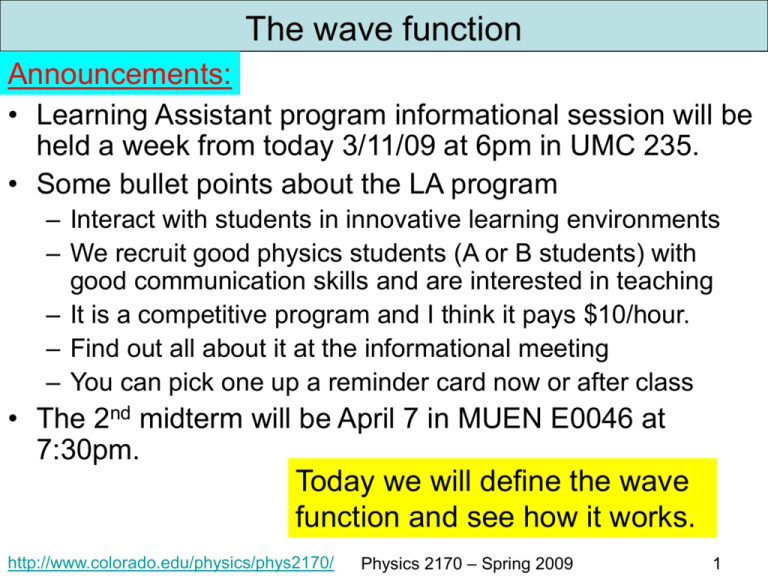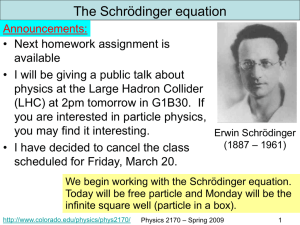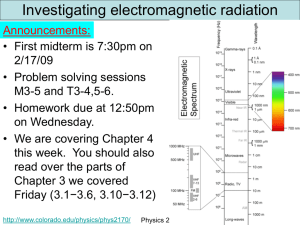wave function
advertisement

The wave function Announcements: • Learning Assistant program informational session will be held a week from today 3/11/09 at 6pm in UMC 235. • Some bullet points about the LA program – Interact with students in innovative learning environments – We recruit good physics students (A or B students) with good communication skills and are interested in teaching – It is a competitive program and I think it pays $10/hour. – Find out all about it at the informational meeting – You can pick one up a reminder card now or after class • The 2nd midterm will be April 7 in MUEN E0046 at 7:30pm. Today we will define the wave function and see how it works. http://www.colorado.edu/physics/phys2170/ Physics 2170 – Spring 2009 1 Maxwell’s Equations describe EM radiation in vacuum: E, B, and k form a ‘right-handed system’, with the wave traveling in the direction of k at speed, c. B Emax=peak amplitude c E( x, t) Emax sin( ax bt) k E standard wave equation 2 2 Intensity Eavg Emax http://www.colorado.edu/physics/phys2170/ Physics 2170 – Spring 2009 2 Two slit interference Standard two slit interference with light causes waves to interfere The amplitude A(x) gives the electric and/or magnetic field of the wave as a function of position. It can be positive or negative. The intensity is proportional to the square of the amplitude I (x) A(x)2 and is ≥ 0. This is what we see! The intensity also tells us the probability that a photon will land in a particular x region. http://www.colorado.edu/physics/phys2170/ Physics 2170 – Spring 2009 3 Set frequency to DA Reading Quiz 1 Please answer this question on your own. No discussion until after. What is the quantity y(x) called? A. Probability density B. Angular field C. Wave function D. Potential energy function E. Schrödinger function http://www.colorado.edu/physics/phys2170/ Physics 2170 – Spring 2009 4 Same thing with electrons Electrons have a wavelength and so two slit interference has the same effect as for light The probability of any given electron hitting near 2 x is determined by y (x) y (x) is called the wave function. It contains everything we know about the electron but only gives probabilities about where the electron is located http://www.colorado.edu/physics/phys2170/ Physics 2170 – Spring 2009 5 Probability versus probability density y (x) is the probability density for finding the electron at point x. 2 To get probability, multiply the probability density by a region dx. y (x) 2 The probability of finding the electron in the region dx shown 2 is y ( x) dx dx x Similar to the relationship between linear mass density and mass. http://www.colorado.edu/physics/phys2170/ Physics 2170 – Spring 2009 6 Probability and probability density are similar to mass and linear mass density. y (x) y (x ) Physics 2170 – Spring 2009 2 2 http://www.colorado.edu/physics/phys2170/ 7 Set frequency to DA Clicker question 1 This is the wave function for a neutron. Around which point is the neutron most likely to be found? A. x = 0 B. x = xA C. x = xB D. x = xC E. There is no most likely place Wave functions exist for any object including electrons and neutrons. The wave functions we have been looking at came from two-slit interference and so were simple sine waves but different functions 2 are also possible. Remember the probability is related to y (x) so need to square the wave function. http://www.colorado.edu/physics/phys2170/ Physics 2170 – Spring 2009 8 The wave function The wave function does not tell you the path of an object like a normal traveling wave function. y(x) The wave function (squared) gives the probability of finding the object at a given x. −L L x Some details about the wave function: Wave function is really a function of the 3D position, y(x,y,z) but many of the problems are 1D so we will start with that: y(x). Wave functions are complex valued (have real and imaginary parts) and are never directly observable. The probability density is observable and is 2 2 y ( x) y ( x) y ( x) y real ( x) y imag ( x) 2 http://www.colorado.edu/physics/phys2170/ y*(x) is complex conjugate: replace i by −i in y(x). Physics 2170 – Spring 2009 9 Getting probabilities from wave functions y(x) Wave function y(x): −L Probability density y (x) 2 y (x) L x L x 2 For an infinitesimal distance 2 y ( x ) dx dx the probability is To find the probability over a finite distance we need to integrate. ab −L Probability of finding electron between a and b is the area under the curve. b Probability of electron being between a and b is y (x) 2 dx a http://www.colorado.edu/physics/phys2170/ Physics 2170 – Spring 2009 10 Normalization Probability density = y (x) y (x) 2 2 Probability of electron being b between a and b is 2 y (x) dx ab −L a L x What if this calculation gives a number larger than 1? Doesn’t make any sense! A properly normalized wave function obeys the normalization constraint: y ( x) 2 dx 1 This is simply a statement that the electron is located somewhere! That is, the probability of finding the electron somewhere is 100%. http://www.colorado.edu/physics/phys2170/ Physics 2170 – Spring 2009 11 Set frequency to DA Clicker question 2 2 If y(x) is a properly normalized y (x) wave function, what is the value of A as shown in the figure? A A. A = 1 2 −L L x B. A = 1 / L y ( x) dx 1 C. A = 1 / 2L D. A 1 / 2L E. A 1 / 4L2 The probability is 0 for |x|>L so we only need to consider the region between –L and L. The electron must be somewhere in 2 that region. In that region we know y ( x) A so applying the normalization condition we get: L Adx 1 L L Ax L 1 so A = 1 / 2L http://www.colorado.edu/physics/phys2170/ AL A(L) 1 2 AL 1 Notice it has units of 1/Length Physics 2170 – Spring 2009 12







